It’s the light in Valletta, Malta that truly enchants. Reflecting off limestone walled cities, citadels, fortresses, towers and batteries, the sun’s rays create a captivating, almost illuminating look. It’s addictive, as travelers can stare at the same buildings viewed just hours before, but as every hour passes, the light imparts a new, different glow and feel to the structures.
One facet of Malta never changes, though. More than 7,000 years of history seemingly “ooze” from every corner, block and crevice of this Mediterranean nation’s fortifications, built or reinforced between 1,450 BC and the mid-20th century. Most notable are the medieval fortification improvements made by the Order of the Knights of St. John (aka Crusaders), but Malta’s history is also laced with tales and structures representing the Prehistoric, Neolithic, Phoenician, Greek, Roman, Byzantine, Crusader and European periods.
Blessed with natural harbors and a strategic Mediterranean locale, the Maltese archipelago today attracts not foreign invaders but modern-day travelers — 2.75 million visitors and 700,000 cruise visitors in 2019. Valletta, Malta’s bustling capital is a UNESCO World Heritage site, an open-air museum of sorts with historic churches, palaces, palazzos, Maltese balconies, fountains, monuments and residences, most between 250 and 400 years old.
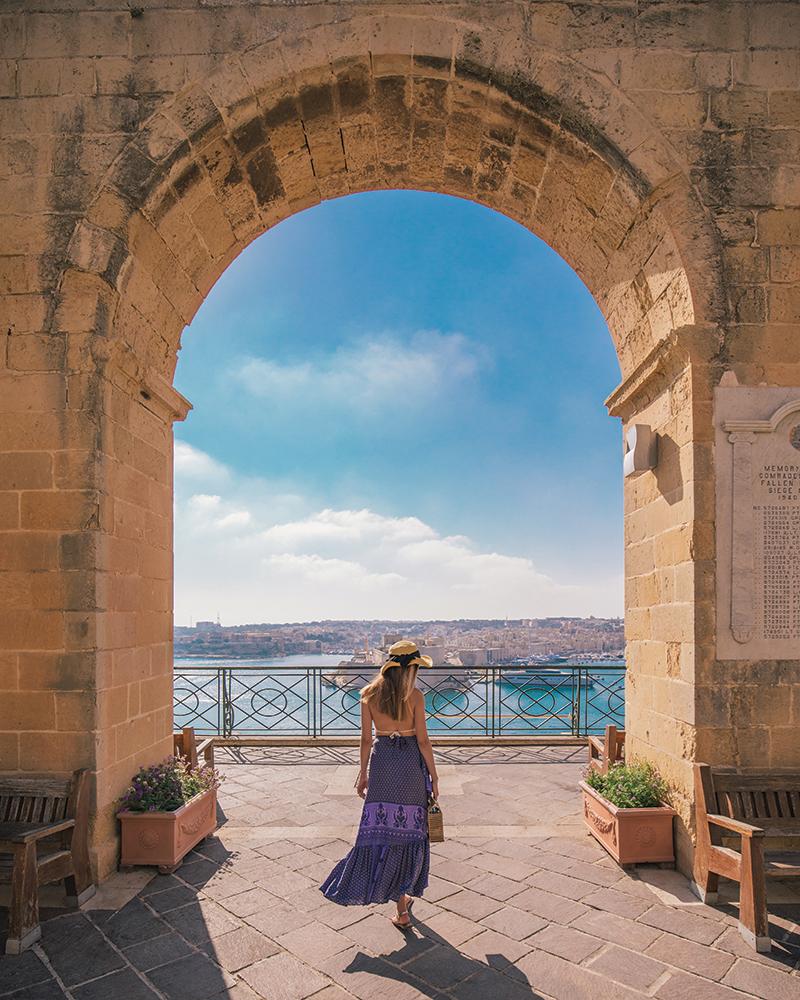
Upper Barrakka Gardens offer views of the 16th-century Saluting Battery, constructed by the Order of the Knights of St. John at Valletta’s Grand Harbour.
While historic sites and fortifications are a huge draw, so are turquoise-colored grottos, beaches, scuba diving and snorkeling sites, as well as art museums and culinary diversions
In addition, visitors often tour medieval Mdina, the well-preserved, walled city and former capital about eight miles from Valletta as well as nearby Rabat. And another of the Maltese isles, Gozo, beckons with more history, quiet towns and pristine beaches.
In September, Luxury Travel Advisor returned to Valletta to cruise on the 930-passenger Viking Venus, and also stayed post-cruise at the Rosselli – AX Privilege, a luxury boutique property in Old Town Valletta. Here’s a sampling of what luxury travelers can see and do.
Valletta’s Historic Core
History buffs can select from a cornucopia of appealing museums and historic sites to tour in downtown Valletta; they include the grandiose “The Palace” (former Grandmaster’s palace ad now the official seat of the country’s President), the Palace Armoury, the National Museum of Archaeology, the Fortress Builders Interpretive Center and Fort St. Elmo (home to the National War Museum). Check websites in advance for hours of operation, though; the Palace’s State Rooms have been closed for renovations.
A relatively new Malta attraction is MUZA, a visual arts museum within the historic building that was once the seat of the Italian knights of the Order of the Knights of St. John. Cited by Architecture Digest as one of 15 noteworthy new global museums, its diverse collection focuses on four themes — the Mediterranean, Europe, Empire and The Artist.
Key works include those by southern Italian artist Mattia Petri, British 20th-century artist Victor Pasmore and Malta’s famed sculptor Antonio Sciortino. What’s nifty is that this museum juxtaposes old masters with contemporary works, offers visitors the opportunity to see “techniques on videos” and has designed interactive experiences complementing the displayed art or object.
When it’s time for fresh air, we recommend a stroll through the Upper Barrakka Gardens—particularly if you can arrive by 11:45 a.m. Head for the railing that overlooks the 16th-century Saluting Battery, constructed by the Order of the Knights of St. John at Valletta’s Grand Harbour. It’s a great perch for a selfie with stellar views of Fort St. Angelo, other fortifications and cruise ships docked in the harbor. At noon most days, though, the big, booming draw is when the Saluting Battery “troops” in full military regalia fire a historic cannon.
Certainly, one “don’t miss” attraction in Valletta is St. John’s Co-Cathedral Malta, commissioned in 1572 by Grand Master Jean de la Cassiere of the Order of the Knights of St. John. Designed by Maltese architect Gerolamo Cassar, it’s dedicated to St. John the Baptist. Inside, travelers will discover Baroque art, frescoes and relics, ornate marble floors, three-dimensional statues and carved stone walls. We loved the lovely, vaulted ceiling showcasing the Italian Baroque artistry of Mattia Preti.
Also, be sure to visit the co-cathedral’s oratory to look for “The Beheading of St. John the Baptist,” one of the largest paintings ever created by famed artist Michelangelo Merisi da Caravaggio; it’s his only signed work. This year, the co-cathedral finished restoring the oratory and opened the Caravaggio Wing; Caravaggio’s painting was fitted with new LED lighting, plus restoration work was completed on 13 paintings by Preti and a gilt wooden soffit.
Want to tour the co-cathedral without daytime crowds? After-hours private tours can be arranged for many of Valletta’s historic attractions including the cathedral. Conducted with a private guide between 4:30 p.m. and 6 p.m., the one-hour private cathedral tours must be booked by a travel advisor at least one month in advance. For information visit, https://www.stjohnscocathedral.com/exclusive-tours/
For those with several days in Valletta, we’d recommend a tour of the Manuel (Manoel) Theater, built in 1731 by Grandmaster Antonio Manoel de Vilhena. One of the world’s oldest theaters, it’s known for its pale blue trompe-l’oeil ceiling, impressive chandelier and perfect acoustics. Located on Old Theatre Street, it’s now considered Malta’s National Theater.
Another historic and cultural option is to tour a historic palazzo. Owners of some grand Maltese residences have opened their doors to allow visitors exclusive, behind-the-scenes access. For example, Casa Rocca Piccola offers a leisurely guided private tour — often given by Marquis and Marchioness de Piro during which travelers can opt to sip Prosecco or Champagne and taste a few local Maltese delicacies.
Gardening fans should consider a tour of the Palazzo Parisio, Naxxar, which has fine, privately owned gardens open to the public; expect Italian symmetry coupled with Mediterranean colors and flora fragrances. Reflecting 19th-century Italian and Maltese craftsmanship, the palazzo will wow visitors with lavishly decorated ceilings, murals and frescoes, fine stucco work, antique furniture, rare paintings and plenty of gilding.
Or, if natural history is a passion, Mdina has an excellent National Museum of Natural History; check out the fossils, bird nests, minerals, ecological exhibits and dioramas of natural Maltese habitats, plus a vast collection of birds and the largest squid ever found in Maltese waters.
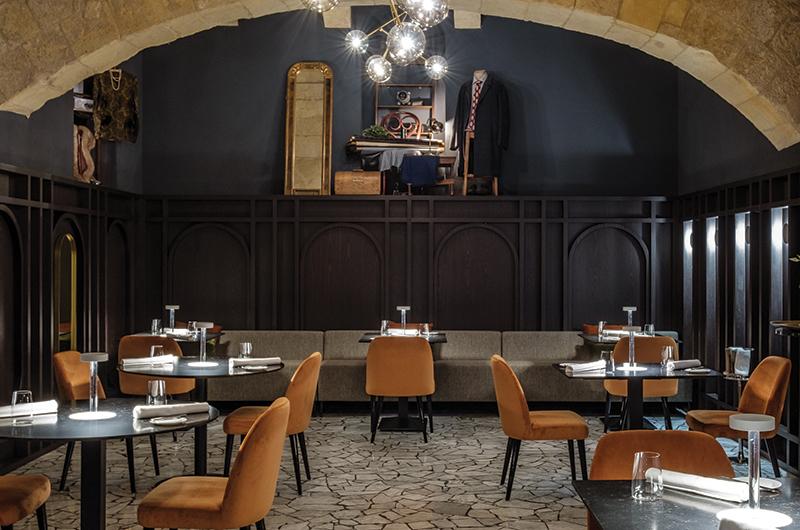
Shown here is a Michelin one-star restaurant at Rosselli – AX Privilege, a luxury boutique property in Old Town Valletta.
A Taste of History
While luxury travelers love to tour the fortifications, among the world’s best examples of military architecture, Heritage Malta recently introduced a new “Taste of History” program — coupling history with cuisine. Available only as an exclusive dining experience for private groups or privately booked individuals, it introduces travelers to traditional Maltese food with recipes curated from history. Menus are created by professional Maltese chefs, plus guests dine in the same venues where the inquisitors, corsairs, knights and libertines once dined.
Luxury Travel Advisor experienced this new culinary program one evening at the Malta Maritime Museum in Birgu. We were greeted by Liam Gauci, the museum’s principal curator, who provided an introductory explanation about the Taste of History concept. It’s based on research gleaned from archives, historical recipe books, kitchen inventories and museum artifacts. The curator shows guests a few artifacts that help relate the cuisine to the site/era (in our case, two historic weapons). Then guests are seated in a lovely private setting with multiple courses delivered to the table, and explanations for each. Advisors can reserve this exclusive, private experience through tastehistory.mt.
When it comes to dining out anywhere in Malta, we’d suggest sampling a few of the traditional, rustic dishes, varying by season. Among those are Lampuki Pie (fish pie), rabbit stew, and Kapunata, which is a Maltese version of ratatouille. On most food shop counters, you’ll also notice Bigilla, a thick pate of broad beans with garlic. Also try the traditional tasty snacks of “hobz biz-zejt,” a round of bread dipped in olive oil, rubbed with ripe tomatoes and filled with a mix of tuna, onion, garlic, tomatoes and capers, and pastizzi, a flaky pastry parcel filled with ricotta cheese or mushy peas.
But whether travelers prefer Maltese favorite dishes or international cuisine, choices abound. In April 2021, the Michelin Malta Guide listed 31 restaurants of note including five designated Michelin one-star eateries; repeaters are De Mondian, Noni and Under Grain. New to that one-Michelin-star list are Bahia and ION – The Harbour.
ION – The Harbour dishes up cuisine by two-Michelin-star Chef Alex Dilling and is nestled within the new Iniala Harbour House luxury property; this eatery’s terrace overlooks the Grand Harbour. Good to know? Toward the end of this year, Bahia will move from its townhouse restaurant location in Lija to a new home on the upper floors of the Villa Corinthia within the Corinthia Palace in Attard.
Another Michelin one-star restaurant is Under Grain, the flagship haute cuisine restaurant of Rosselli – AX Privilege, a luxury boutique property in Old Town Valletta. The restaurant opened in 2020 and achieved a Michelin star just a few months after its opening; that star was retained in 2021. Executive Head Chef Victor Borg has created classic dishes that have been reimagined by combining new ingredients with farm-to-table meats and poultry.
Malta’s vineyards also invite luxury travelers to enjoy exclusive access to their tasting rooms. Guests can step onto a terrace and enjoy a glass of wine overlooking the vineyards. International grape varieties grown on Maltese islands include Cabernet Sauvignon, Merlot, Syrah, Grenache, Sauvignon Blanc, Chardonnay, Carignan, Chenin Blanc and Moscato, but be sure to sample Gellewza and Ghirghentina, Malta’s tasty indigenous grape varieties.
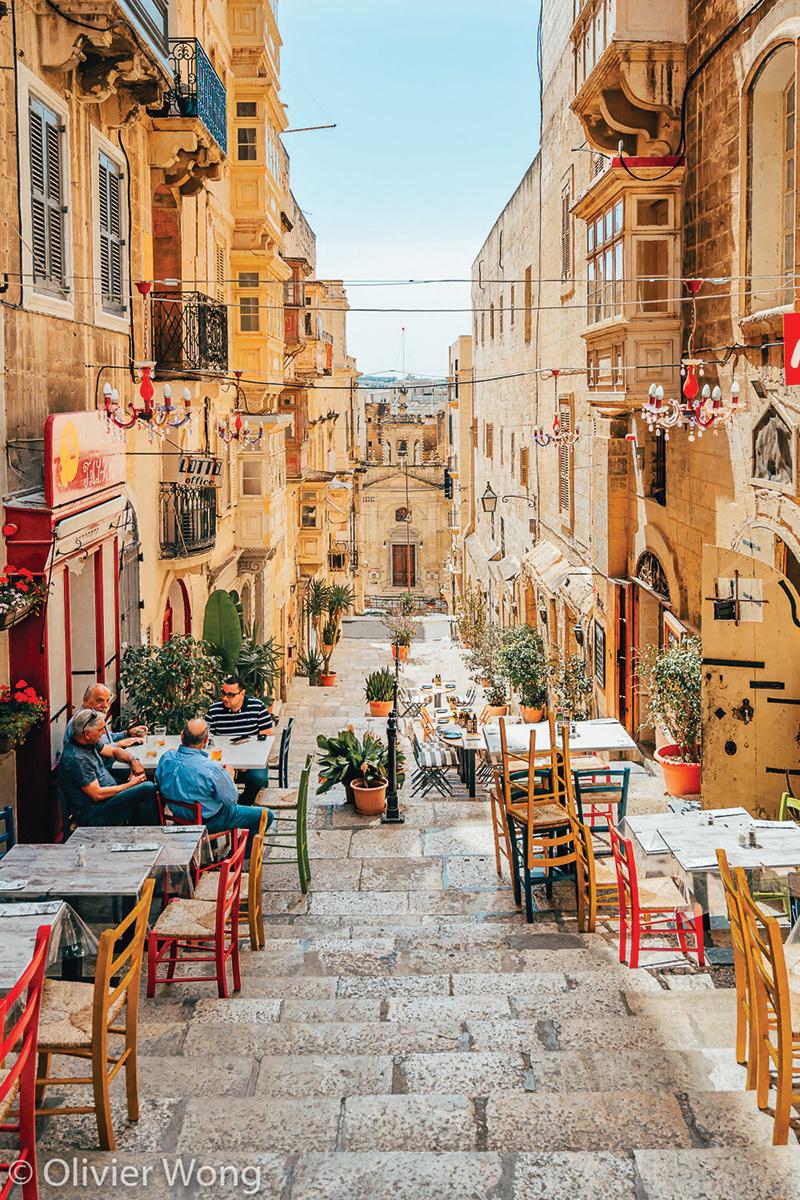
Shown above is outdoor dining in the Maltese capital.
Water Play
The secluded bays, warm waters and uninhabited islands of Malta beckon luxury travelers with the destination’s many options for private boat charters. Travelers can swim, snorkel, scuba dive in crystal clear turquoise waters, explore the caves and rock formations of Gozo Island, sail south of Malta to Marsakala Bay, take a dip in St. Peter’s Pool, or explore the Blue Grotto, home to a huge natural arch in the sea cliffs.
Thirty-minute Blue Grotto boat trips take visitors to view the entry to seven caves including the Honeymoon Cave, Reflection Cave and Cat’s Cave. Hint? The best viewing time to see the Blue Grotto is “before midmorning” when the sun is shining into the grotto. If headed to the grotto by boat, consider a snack or meal afterward at the nearby seaside hamlet of Wied iz-Zurrieq.
We stopped here at the casual Step In+, an eatery with outdoor patio space atop the seaside hillside; a path leads down to the boat area. If you go, we’d recommend seafood lovers order the octopus in garlic or mussels in shells, with salads, beef, chicken and veggie dishes also available. A traditional Maltese Platter is comprised of peppered goat cheese, sun dried tomatoes, pickled onions, olives, broad beans and Maltese biscuits. Plus, the menu offers more than a dozen kinds of pizza.
Beach lovers have many options in Malta, but many travelers enjoy pretty Golden Bay Beach or Gnejna Bay Beach, as well as beaches in Gozo.
Luxury and Private Accommodations
Malta’s luxury accommodations include a mix of luxury hotels, historic boutique hotels, 16th- and 17th-century “Palazzos” (mansions of nobles), private villas, and historic farmhouses. Malta’s official, five-star property list has 17 properties, three that has opened or reopened with refurbishments.
Opened in 2020, the Hyatt Regency, St. Julian’s Malta offers luxurious one-bedroom, 592-foot Ambassador’s Suites, while the Malta Marriott Hotel & Spa, St. Julian’s, is a property that’s undergone a $35 million renovation/update. We’d suggest sun lovers head for the roof top pool. In addition, the new Iniala Harbour House & Residences, Valletta, opened in 2020, with 23 uniquely designed rooms; it’s spread among four Maltese houses and their vaults below — and located on St Barbara Bastion overlooking the Grand Harbour. It also has a Michelin one-star restaurant, as mentioned earlier.
Our stay was at Rosselli - AX Privilege, a lovely luxury boutique hotel in the historic core of Valletta, which opened in 2019. We loved the character of this former 17th-century palazzo, whose original owners were Pietro Rosselli, an avant-garde goldsmith and philanthropist, and Alusietta Massa Rosselli from the established Massa family.
With classic Renaissance and Baroque architecture, the historic centuries-old palazzo turned boutique hotel was renovated with care. Opening in 2019, the updated architecture remains true to the building’s original characteristics such as retention of its Maltese balconies, but at the same time, its renovation incorporated contemporary elements, styles and materials. So, guests will discover colored marble, brass, wood, glittering mirrored glass and bold wallpaper design. That said, the Rossellis — in spirit at least — are ever present. Just check out the large wall paintings of them (prim-and-proper for the era) peering down into the reception desk area.
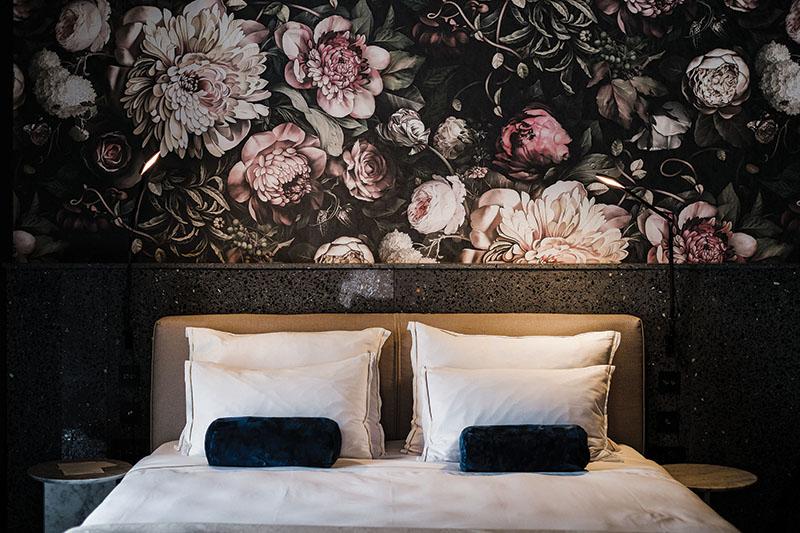
Rosselli – AX Privilege has 25 unique designer rooms. Shown here is a superior room — Alusietta.
Offering 25 unique designer rooms, Rosselli – AX Privilege impressed us with its friendly front-desk staff, soaring palazzo atrium, elevator to the upper floors and well-appointed, comfortable accommodations. We stayed in No. 301, which was spacious with two twin beds, marble-topped, small end tables, a large wall-mounted flat screen TV, desk and desk chair. The bathroom design featured one sink, a toilet and humongous “fully open” rainforest shower at one end.
To splurge, though, we’d reserve one of five designer rooms and suites within the palazzo’s Piano Nobile, the principal floor that would have typically served as the main living and sleeping quarters of the house. Each of these accommodations has a traditional wooden Maltese balcony with views to the sea, the old university or Jesuit church dome.
This boutique luxury property has several nice guest touches. A concierge will assist with destination insight. Wi-Fi is available throughout the property. In addition, guests can relax with a drink in hand at the plunge pool on the fourth floor. Continental breakfast is also served for guests in Grain Street, more casual and convivial than the one-Michelin-star Under Grain.
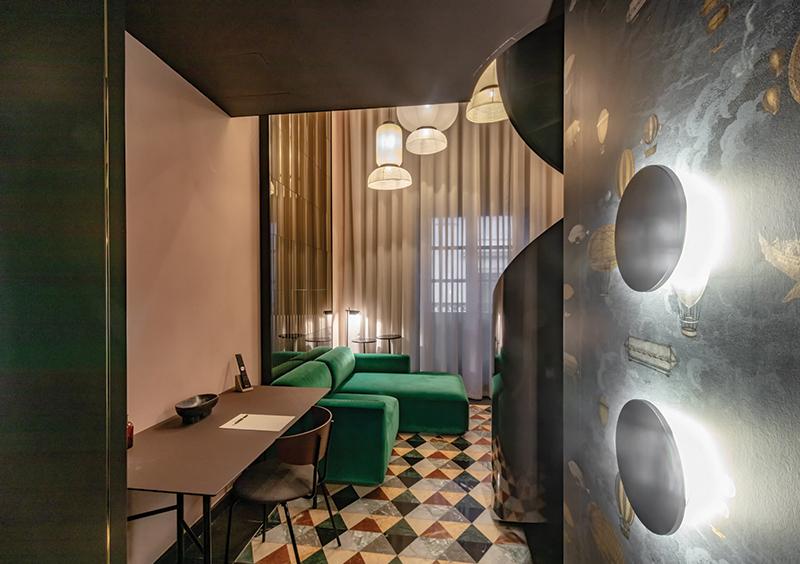
The Three Herons suites at Rosselli – AX Privilege are duplex rooms located at the Piano Nobile.
What’s new? Luxury Travel Advisor watched in early September as a new platform was being built just in front of the property “in the street” within the city’s historic core. Starting November 1, it will become a new Grain Street al fresco dining platform, where guests can sip a glass of Maltese wine and taste authentic dishes, while dining outside amid Valletta’s street vibes.
For something authentic and a bit different, those seeking a quieter vacation experience can stay at a luxury farmhouse on the Maltese island of Gozo. Since the island is smaller than Malta, it has fewer people, yet beautiful beaches, historic sites and a great variety of local restaurants. Also, a new fast catamaran service has been introduced between Gozo’s Mgarr harbor and Valletta. Gozo has many upscale farmhouse-stay options; they offer modern amenities, many have private pools and some offer superb views. To learn more, visit www.visitmalta.com.
Looking Ahead
During the pandemic, the Maltese government has invested millions of dollars in training for tourism industry personnel and “upscaling” tourism offerings, including support for redesign, reconstruction, and green initiatives. The industry too — hotels, DMOs and transportation sectors — have invested in enhancing their facilities. Large infrastructure projects are under way to improve road networks and build more yacht marinas.
Newly launched this year is Heritage Malta’s Underwater Cultural Heritage Unit (UCHU), which is set up to manage and protect underwater cultural assets. It aims to establish the islands as a prime deep-water historical wreck diving destination. There are also projects in the pipeline that will greatly improve the diving experience around Malta, among them are deep-sea artificial reefs and underwater sculptures.
Malta Tourism Authority also plans to further improve the current events calendar by adding events of international caliber. Finally, on the eco-side, an extensive shore-power connection project that’s underway will allow cruise ships to eventually plug directly into Malta’s electric grid while docked (rather than running their engines).
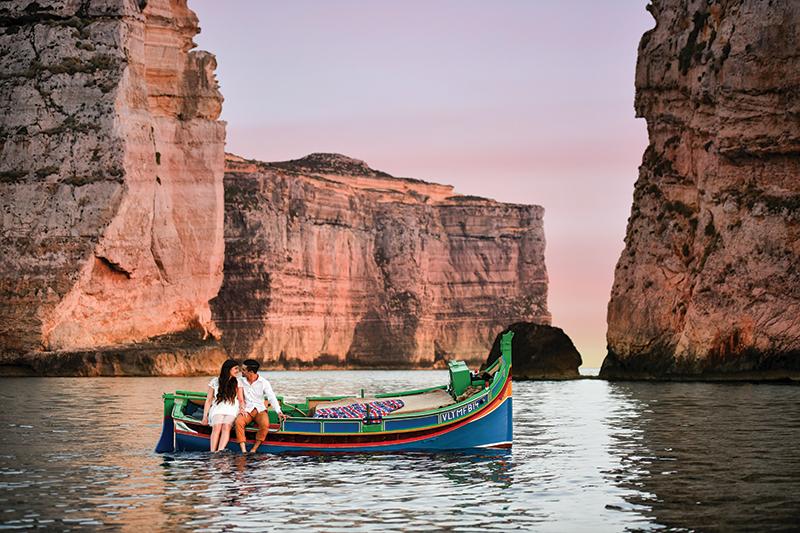
Gozo is an island known for its history, quiet towns and pristine beaches. Shown here is a couple on Luzzu in Dwejra Bay, San Lawrenz, Gozo.
Experiencing Ancient Times
While the structures and fortifications of the Knights of the Order of St. John are historic, Malta’s history extends back more than seven millennia. Here’s how to dive even deeper into the past.
Designated a UNESCO World Heritage Site, the Hal Saflieni Hypogeum, dating to 4,000 B.C., is one of Malta’s oldest burial grounds, and the world’s only prehistoric burial site open to visitors. If travelers go, they’ll discover interconnecting rock-cut catacombs, an oracle chamber, and the “Holy of Holies,” with megalithic temple architectural features. But to preserve this fragile treasure, capacity is limited to 10 visitors per hour for a maximum of eight hours a day. Buy tickets online and as early as possible; guided tours are booked weeks in advance.
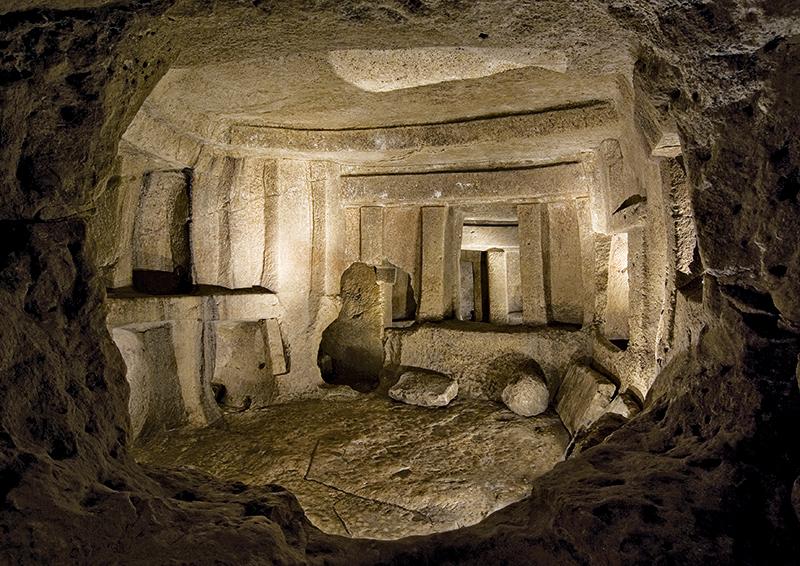
The Hypogeum, dating to 4,000 B.C., is the world’s only prehistoric burial site open to visitors.
What’s older than the Stonehenge or the Egyptian pyramids? It’s Malta’s Ggantija Temples, one of the world’s oldest free-standing monument sites. Located just above the water on Malta’s southern coast, these temples represent the cultural, artistic, and technological developments of life in 3,600 B.C. Nearby the Temple of Hagar Kim is perched on a hilltop overlooking the sea and a short distance way is another Megalithic temple site, Mnajdra, above the southern cliffs.
Related Articles
E.U. to Allow COVID Certificates to Expire Without Booster
The Grand, York: Five-Star Splendor in Historical York